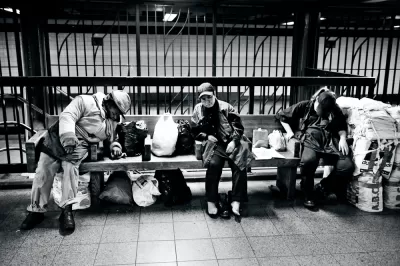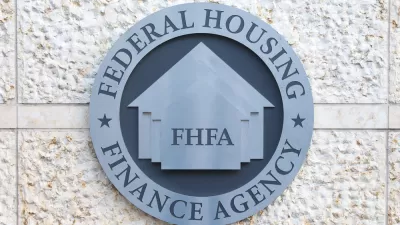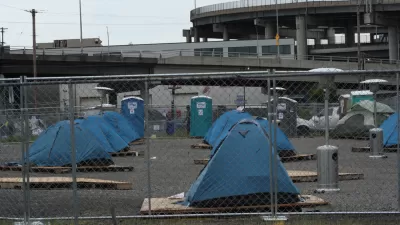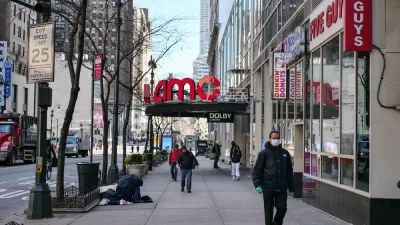Cities, states, and the federal government are trying to prevent a repeat of 2008 while still facing the challenges of inequality and poverty that grew out of the previous recession.

Some of the challenges facing the United States previous to the spread of COVID-19 seem to have faded into the background. Congestion, for instance, and pollution, have been greatly reduced as Americans have stayed home by the millions.
Some challenges persist, but have seemingly moved down the list of priorities during the public health and unemployment crisis. The lack of open space in many U.S. cities probably seemed like a challenge that could wait until after the pandemic, until it wasn’t. The debate about which priorities should take precedence changes focus daily, but homelessness and the housing crisis are preexisting conditions that can’t be swept under the rug as most of the country shelters in place for the worst of the pandemic.
The coronavirus was always going to have the largest impacts on the most vulnerable populations, but the unprecedented scale of the current emergency threatens to overwhelm all available resources for the homeless, as well as those already living paycheck to paycheck and devoting huge portions of their income to pay the rent. As the clock ticks on the spread of COVID-19 among homeless populations, so too does the need for rent relief for millions of Americans facing sudden unemployment as rent comes due for April.
Homelessness in a Pandemic
The risks of homelessness during a pandemic aren’t alleviated in homeless shelters, where people sleep in close quarters that lack essential hygienic tools like soap and hand sanitizer. According to reports from Orange County, California, homeless shelters are ill-equipped to prevent the spread of coronavirus among homeless populations. Homeless people report that conditions in homeless shelters are less preferable than life on the streets, especially during a pandemic. In some cities, at least, local officials and law enforcement have decided not to force the homeless into a choice between seeking shelter, thus risking death, or staying outside and risking arrest. The city of Los Angeles announced on March 17 that it would no longer enforce daytime camping laws, historically used by law enforcement to disband homeless encampments. San Francisco also paused sweeps.
The potential of many homeless people to get sick during the pandemic will still require more quarantine and recovery facilities. Earlier this month, California Governor Gavin Newsom announced a plan to turn hotels and motels into emergency housing for the homeless throughout the state. On March 16, the state signed leases for 393 rooms in two hotels near the Oakland airport to house homeless people. Governor Newsom also promised the deployment of 450 state-owned trailers to house homeless populations during the pandemic.
Clearly, 393 rooms in Oakland, a city with more than 4,000 homeless residents, isn’t going to cut it, similar to the nationwide shortages of masks, ventilators, and hospital beds, but the shortage of shelter space won't be the only other difficulty in supporting homeless people through the pandemic. An article dated March 15 by Jeff Stein and Tracy Chan reported shelter workers staying home at “an alarming rate” around the country as concern grows about the health and safety of outreach workers.
Not Just California’s Problem
The Trump administration has made a habit of blaming the nation’s homelessness on California, but other cities are scrambling to prepare for the potential of the pandemic to spread through the homeless population. City officials in Phoenix are similarly concerned about the coronavirus spreading among homeless populations. With no known cases in its homeless populations as of March 17, homeless support providers in Phoenix were already taking actions to prevent or slow the spread of the virus in the city’s large homeless population, despite obvious limitations. According to an article by Jessica Boehm, the city’s Human Services Campus lacks resources and supplies to handle a worst-case scenario. “They don't have the supplies, staff or funding they will need to protect their employees and the people they serve — and they're asking state, county and federal partners to step up and help them prepare,” writes Boehm.
Similar stories are reported in St. Louis, where homeless service providers are responding to shortages of masks and food, while Mayor Lyda Krewson negotiates for additional shelter space at local motels, according to an article by Nassim Benchaabane.
Making Sense of the Patchwork
At present, a patchwork approach is the only kind of approach available to combat the spread of coronavirus in homeless populations. In California, for instance, there is no single state entity with oversight over safety in shelters, according to an article by Sam Levin.
A federal judge attempted last week to step into an oversight role in the city of Los Angeles during a hearing on March 19. U.S. District Judge David O. Carter called city and county officials like Mayor Eric Garcetti, City Attorney Mike Feuer, Police Chief Michel Moore, County Supervisor Kathryn Barger, and City Council President Nury Martinez to appear in court, after a lawsuit filed by the L.A. Alliance for Human Rights accusing the city of allowing unsafe and inhumane conditions in encampments. The Los Angeles Times described the hearing as "wild."
The federal government has also taken some action to provide funding and leadership. The recently announced stimulus package includes $4 billion in Emergency Solutions Grants to assist homeless shelters and outreach workers to assist homeless shelters and outreach workers to reduce risks. Advocates are also pressing the federal government to take a leadership role in building and operating shelter capacity to supplement the local and state efforts already underway. U.S. Department of Housing and Urban Development Secretary Ben Carson, “said [last] week that the Federal Emergency Management Agency would probably bear responsibility for handling a response to the potentially massive increase in need for shelters,” report Jeff Stein and Tracy Jan. Earlier this month, “the U.S. Department of Housing and Urban Development also took the unprecedented step of publishing guidelines for preventing and managing the spread of infectious diseases among people living on the streets and in shelters,” according to the Los Angeles Times.
Protecting the Margins
The homeless aren’t the only Americans facing sudden stress due to the pandemic. The coronavirus emerged into a country already beset by huge gaps in housing affordability—more than ten percent spending more than half their income on housing due to a lack of affordable options. In 2018, about half of all renters in the United States paid more than the recommended third of their income on rent, according to data from the Joint Center for Housing Studies of Harvard University, and about a quarter of renters spend more than half of their income on rent.
Every level of the housing market—except for the most affluent, long-time homeowners (and private equity firms), who have been riding the largesse of the market for years—is at risk in the current crisis. The U.S. housing market was totally unprepared for the pandemic, according to an article written Brooking Institution fellow Jenny Schuetz on March 12.
On March 10, the city of San Jose, California planned emergency measures that would prevent evictions for renters who could document a loss of work due to the pandemic. San Francisco planned similar measures. Los Angeles approved a moratorium on evictions related to rent payments, but stopped short of relieving rent entirely and also still allows evictions for other reasons. Miami-Dade suspended evictions and water cut-offs during the emergency. Evictions are illegal in the state of Pennsylvania, and the Supreme Court of Pennsylvania has ordered all courtrooms in the state to close until Monday, April 6. “Without a court order, it is illegal to evict anyone [in Pennsylvania],” according to an article by Jake Blumgart. Anecdotes in Philadelphia suggest landlords are proceeding with illegal evictions anyway, so Philadelphia Mayor Jim Kenney and other city officials had harsh words for such landlords at a press conference earlier this week.
Halting evictions isn’t the panacea many would hope, however. According to a March 25 article by Jenny Schuetz, rent does more social good than just “[lining] the pockets of fat cat landlords.” Rent money eventually contributes to local property taxes and the wages in the service sector (e.g., plumbers, gardeners, and cleaning services). Thus, the ripple effects of an eviction moratorium could spread through local economies. Schuetz suggests that it would be better for landlords—for landlords, local economies, and local governments—to collect some rent rather than no rent, even in the form of negotiated reduced rents.
Many actions proposed in response to the crisis are less targeted to preventing homelessness and protecting renters than they are to preventing a housing market meltdown reminiscent of the financial crisis in 2008. The federal government has promised relief for mortgages backed by Freddie Mac, Fannie Mae, and the Federal Housing Administration (FHA), in an effort to prevent the kind of wave of foreclosures that caused the fiscal crisis of 2008. Other forms of housing are also at risk. Alicia Robinson reported on the risk to RV dwellers, for instance, as campgrounds and other public spaces close in response to the pandemic.
To keep track of the numerous ongoing efforts to provide support to Americans who have recently lost jobs or are out of work with illness, the National Low Income Housing Coalition has set up a website to track such efforts, cataloguing efforts at the federal, state, and local levels.
Long-Term Benefits Are Possible
Some of the actions described above could be construed as a massive effort on the part of governments to ease the stress of housing and homelessness during the pandemic. This newfound political will, or some of the assets created in response to the emergency, could potentially achieve lasting benefit to one of the country’s most stubborn challenges. If the stakes of this pandemic could inspire more humane treatment of the homeless, and more housing opportunities for those living in poverty, the pandemic could have been for some good. Multiple stories cited in this review described the rescission of criminality for homelessness in cities like San Francisco and Los Angeles, and the urgency in actions by the state of California to house the homeless, as a potential silver lining in the pandemic.
The vast majority of Americans alive right now have never faced an emergency of this scale. The pandemic will be a disaster for homeless people in the United States without swift and decisive action to provide support, while simultaneously defeating the virus and stabilizing the economy. With homelessness and the housing crisis, however, the short- and long-term consequences of the pandemic can still be influenced by the scale, and the effectiveness, of the response.

Maui's Vacation Rental Debate Turns Ugly
Verbal attacks, misinformation campaigns and fistfights plague a high-stakes debate to convert thousands of vacation rentals into long-term housing.

Planetizen Federal Action Tracker
A weekly monitor of how Trump’s orders and actions are impacting planners and planning in America.

Chicago’s Ghost Rails
Just beneath the surface of the modern city lie the remnants of its expansive early 20th-century streetcar system.

Bend, Oregon Zoning Reforms Prioritize Small-Scale Housing
The city altered its zoning code to allow multi-family housing and eliminated parking mandates citywide.

Amtrak Cutting Jobs, Funding to High-Speed Rail
The agency plans to cut 10 percent of its workforce and has confirmed it will not fund new high-speed rail projects.

LA Denies Basic Services to Unhoused Residents
The city has repeatedly failed to respond to requests for trash pickup at encampment sites, and eliminated a program that provided mobile showers and toilets.
Urban Design for Planners 1: Software Tools
This six-course series explores essential urban design concepts using open source software and equips planners with the tools they need to participate fully in the urban design process.
Planning for Universal Design
Learn the tools for implementing Universal Design in planning regulations.
planning NEXT
Appalachian Highlands Housing Partners
Mpact (founded as Rail~Volution)
City of Camden Redevelopment Agency
City of Astoria
City of Portland
City of Laramie





























